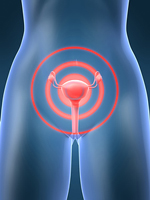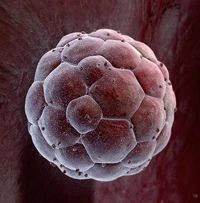Cervical cancer is a severe disease that can pose a threat to a woman's life.
Content
 Cancer may occur in cases where the cells of any body area are raised modified compared to the norm. Cervical cancer is the growth of pathologically changed cervical cells. The cervix is part of the uterus connecting its upper part with the vagina.
Cancer may occur in cases where the cells of any body area are raised modified compared to the norm. Cervical cancer is the growth of pathologically changed cervical cells. The cervix is part of the uterus connecting its upper part with the vagina.
Cervical cancer is a severe disease that can pose a threat to a woman's life. It occurs in women infected with certain types of HPV. If the immune system does not cope with this infection, the normal cells may begin to grow incorrectly and the precancerous changes occur.
In the absence of early detection and treatment, such an abnormal growth of cells can be transformed into cancer. In most cases, it takes several years, although in rare cases the process may take no more than one year.
Cervical cancer cause certain types of HPV
Who has a cervical cancer and precancerous changes?
Cervical cancer and precancerous changes can develop in women infected with certain HPV types that the body could not cope with this viral infection.
About half of all women who have found cervical cancer were aged 35 to 55 years. Many of these women most likely had a contact with the types of HPV, causing cancer, aged 10-20 years or between 20 and 30 years.
Most women who have developed cervical cancer may have never passed Papnicolau test.
How to find out if I have cervical cancer or precancerous changes?
Pre-radically changes and early stages of cancer are usually not accompanied by clinical symptoms. They are often found for the first time at later stages of the disease.
Signs of illness may appear when the tumor grows and grows into the surrounding fabrics. The most frequent symptom is pathological vaginal bleeding, which occur at different times between menstruation or are stronger than ordinary menstruation. Pain during intercourse can also be a symptom of cervical cancer. It should be noted, however, that these symptoms can be manifestations and other diseases, in addition to cervical cancer to clarify the cause of such symptoms, a woman should consult a doctor.
Padnicolau test is one of the best methods that contribute to the prevention of cervical cancer.
The cervical cancer and abnormal cells are detected using papanicolau dough (papanicola smear). If this test testifies to the presence of anomalous cells in the cervix, then doctors can recommend a woman to repeat it, pass the analysis on the HPV DNA, make a colposcopy (study of the cervix with a magnifying device) or to undergo biopsy (taking a bioptate sample - to study in laboratory).
Difficult from the norm The biopsy result can be described as Cin (Cervical IntraePithelial Neoplasia), or intraepithelial neoplasia cervix. Term «Neoplasia» Indicates abnormal growth of cells. Term «intraepithelial» Refers to a cell layer covering the surface of the cervix. The term CIN with related numbers (from 1 to 3-x) denotes the depth of replacement of normal cells of the epithelial layer with anomalous cells. The term CIN 3 means that deeply transformed cells occupy the entire surface layer of the cervix.
How to treat cervical cancer and precancerous changes?
Most of the abnormal cells in the epithelial layer of the cervicals over time is the sore. With small deviations from the norm, the doctor can choose the tactics of careful observation of the patient. With more pronounced deviations from the norm, the removal of altered cells can almost always prevent the development of cancer in the future.
The methods currently used to influence the changed cervical cells, include freezing, removing with an electrical tool and normal surgical removal if abnormal cells occur again, then treatment can be repeated.
The three main methods for the treatment of cervical cancer are: Surgical tumor removal, radiation therapy (use of high energy radiation for the destruction of cancer cells) and chemotherapy (the use of drugs for suppressing cancer cells). Sometimes treatment includes two or more of these methods.
Human papilloma virus (HPV)
What is HPV?
HPV is a widespread virus that affects both women and husband-Chin. There are more than 100 types of this virus. Most of the types of HPV do not cause any symptoms, harmless and disappear from the body themselves.
About 30 types of HPV are called genital HPV, as they affect the genital region. Some of these types can cause cervical cancer or appearance in the surface (epithelial) layer of the cervix of anomalous cells that can transform into cancer. Other types of HPV can cause genital warts and benign (t. E. not related to cancer) cervical changes.
The connection of HPV with other rare diseases, such as Cancer Vulva and Vagina, and with RRP (recurrent respiratory papillomatosis) - the disease of the upper respiratory tract, difficult to breathe.
In the world from cervical cancer, more than 650 women die every day.
Who is infected with HPV?
According to the World Health Organization estimates, in the world of HPV, approximately 630 million are infected. Human. Anomalous cells in the cervix and precancerous states that can go to the cervical cancer, are available at about 40 million. women.
Since people who are infected with HPV may not be noted any signs and symptoms of infection, they, without knowing it, can transmit this virus to other people. Persons practicing any types of sexual activity, accompanied by genital contact, can be infected with genital types of HPV, even if the sexual act did not have a place.
According to estimates, in the world up to 40 million. Women are infected with HPV.
How to find out if you have HPV?
HPV usually does not cause any symptoms, and most people infected with HPV do not know about it. Most cases of HPV infections are first detected on the basis of Papanicolau test results. This test is part of the gynecological examination and helps to identify abnormal cells in the surface layer of the cervix before their possible transformation into precancerous changes or in the cervical cancer.
Many precancerous changes in the cervix (t. E. Changes that can lead to cancer) are associated with HPV, and they can be successfully heal in case of early detection. That is why it is so important to identify such changes in advance.
How to treat HPV infection?
Currently there are no ways that proven healing HPV infection. Most people infected with HPV, the body itself successfully copes with this infection.
At the same time, it is possible to treat some possible consequences of HPV infections, including abnormal cervical cells, cervical cancer and genital warts.
Vaccine has no indications for the prevention of recurrent respiratory papillomatosis.
Genital Condylomas
What is genital condylomas?
Genital Condylomes are bodily color of growing, which are most often caused by certain types of VGCH. Both women and men, genital condylomas are most often arising on external genitalia and anus. Rightly, genital condylomas arise into the vagina or on the cervix.
According to estimates, genital condylomas will arise throughout the life of about 10% of men and women.
How to find out if you have genital conglings?
Genital conglishers often do not cause any symptoms. In some cases, however, they can cause burning, itching and pain.
Doctors usually recognize genital condylomas by simple inspection. Sometimes they are found in control examinations after obtaining the definition of analyzes.
How to treat genital conglings?
Sometimes genital condylomas disappear by themselves without any treatment. However, one can never say whether they will disappear or will increase in the amount.
The doctor may decide to process genital condylomas with a special cream or solution. Alternatively, some genital condylomas can be removed by freezing, electrocoagulation or destruction by a laser beam. If these types of treatment do not bring the desired result, the condylomas can be removed surgically.
There is a possibility that after treatment, genital condylomas will arise again, since the HPV caused them can still be maintained in the body.









